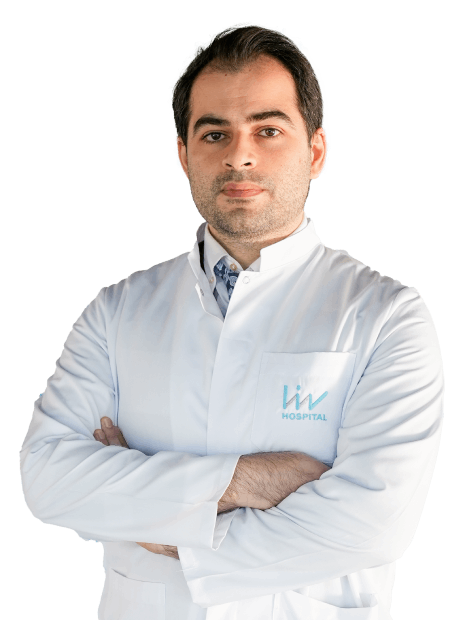Buccal fat removal, an aesthetic surgery procedure preferred by individuals aiming to slim down facial contours, reduce cheek fullness, and alter facial shape. This surgical procedure aids in achieving a slimmer facial appearance.
What is a Bichectomy Surgery?
Bişektomi is the surgical removal of buccal fat pads located in the cheeks, which contribute to the fullness of the face. This procedure is chosen for aesthetic and facial contouring purposes. By removing buccal fat pads, facial contours can become slimmer and more defined. The operation is performed through small incisions made either under the chin or inside the mouth. Carefully selected incisions make the scars nearly invisible. After the buccal fat pads are removed, facial contours become more pronounced, resulting in a slimmer facial appearance.
What is Jawline
Jawline is the area, formed by the jawbone and muscles in the chin. A defined jawline can contribute to a more attractive and youthful appearance of the face aesthetically. Jawline aesthetics can be achieved through various methods to enhance or reshape the jawline. The buccal fat removal procedure, or bişektomi, can help make the jawline area more defined and precise by removing excess fat from the cheeks.
Who is Bichectomy Surgery Applied to?
Bichectomy or buccal fat removal surgery is typically considered for individuals who are bothered by fullness in their cheeks or round facial contours and desire to slim down and define their facial features. Reasons for considering this surgery include:
- Individuals who are bothered by fullness in their cheeks and desire a slimmer and more defined facial appearance may consider buccal fat removal surgery.
- Those with round facial contours may want to shape their facial features into a more oval and slender appearance.
- People genetically predisposed to excess fullness in the cheeks may consider bişektomi surgery to achieve their desired facial contours.
- Bichectomy surgery can be preferred for aesthetic and facial contouring purposes, enhancing facial features and achieving a slimmer appearance.
While these are common candidates for bişektomi surgery, each individual's situation and needs may vary.
What are the Steps of a Buccal Fat Removal Procedure?
The buccal fat removal procedure involves the surgical removal of buccal fat pads for aesthetic reasons. Buccal fat removal is particularly preferred by individuals who are bothered by cheek fullness and round facial contours. Before the surgery, the individual's health status is assessed by consulting with a plastic surgeon, and guidance is provided regarding their expectations. The basic steps of buccal fat removal are as follows:
- Anesthesia Application: During the operation, the patient is put under anesthesia to ensure they are asleep and feel no pain.
- Incisions: The surgical team typically makes small incisions inside the patient's mouth, usually in the natural creases of the cheeks. These incisions are designed to be hidden from view externally and leave no prominent scars after the surgery.
- Identification of Buccal Fat Pads: Through the incisions, the surgeon identifies the buccal fat pads located inside the cheeks. These fat pads contribute to the fullness of the face.
- Removal of Buccal Fat Pads: Carefully, the surgeon removes the buccal fat pads, allowing for a slimmer and more defined facial appearance.
- Closure of Incisions: After the buccal fat pads are removed, the surgeon closes the incisions with sutures. These sutures help securely close the surgical site and expedite the healing process.
Before and After Care Tips for Buccal Fat Removal Surgery
Preoperative consultation with a plastic surgeon is important to determine the suitability of the surgery for the individual. The surgeon evaluates the candidate's health status, explains the expected outcomes and potential risks of the surgery. Information is provided to the individual about how the surgery will be performed and the approach that will be used. Health assessments and necessary tests may be conducted, and it may be necessary to refrain from smoking and certain medications. Additionally, fasting from food and water may be required before the surgery.
After the surgery, some side effects may occur. Swelling, bruising, and mild pain are normal and typically subside within a few days. Rest and adequate sleep are important postoperatively, and it is necessary to avoid physical activities and rest as recommended by the surgeon. The diet is adjusted to include soft and liquid foods. The surgeon prescribes appropriate medications for pain control. Regular follow-up examinations are conducted after the surgery to assess the healing process and address any issues that may arise.
Side Effects of Buccal Fat Removal
Buccal fat removal surgery can cause some side effects. The side effects of buccal fat removal are as follows:
- Swelling and bruising: Swelling and bruising may occur in the cheeks after buccal fat removal. This typically diminishes over time but can be pronounced at the beginning of the healing process.
- Pain and discomfort: Pain and discomfort after surgery are common. However, pain relievers prescribed by the surgeon and specific care instructions usually help manage this process.
- Temporary sensory changes: Temporary sensory changes in the cheek area may occur after surgery. This occurs due to the procedure performed on the cheek tissue.
- Infection: Like any surgical procedure, there is a risk of infection after buccal fat removal. This risk is higher in non-sterile operations not performed by a specialist surgeon.
- Asymmetry: Ensuring equal thinning of the cheeks can be challenging, and asymmetry may occur in some cases. The experience and skill of the surgeon can help minimize such situations.
- Loss of cheek tissue: Removal of buccal fat can result in cheeks appearing more sunken and thin over time due to the aging process.
* Contents of this page is for informational purposes only. Please consult your doctor for diagnosis and treatment. The content of this page does not include information on medicinal health care at Liv Hospital .
